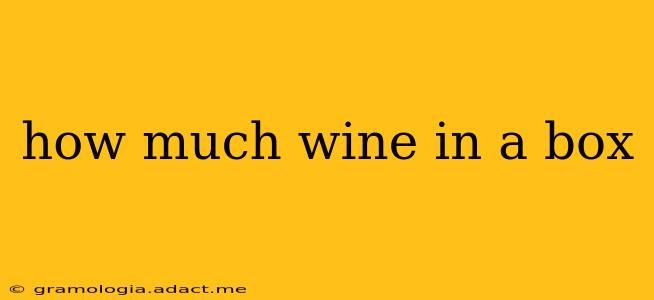How Much Wine is in a Box? A Comprehensive Guide to Boxed Wine
The question "How much wine is in a box?" seems simple, but the answer isn't always straightforward. Boxed wine, also known as bag-in-box wine, comes in various sizes, making it crucial to understand the different options available. This guide will delve into the common sizes, their advantages, and dispel some common misconceptions.
What are the Standard Sizes of Boxed Wine?
The most common size of boxed wine is 3 liters (approximately 4 bottles of wine). This is equivalent to about 101 fluid ounces. However, you can also find smaller boxes, typically holding 1.5 liters (about 2 bottles of wine), and larger formats, although these are less prevalent in the market. Always check the label to confirm the exact volume before purchasing.
Why are Different Sizes Available?
The variety in boxed wine sizes caters to different needs and consumption patterns. Smaller boxes are ideal for individuals or couples who might not consume a larger quantity before the wine starts to oxidize. Larger boxes, on the other hand, are perfect for parties or larger gatherings.
How Long Does Boxed Wine Last?
This is a frequently asked question, and the answer depends on several factors, including:
- The type of wine: Lighter-bodied wines generally have a shorter shelf life than bolder reds.
- Proper storage: Keeping the box upright in a cool, dark place will significantly extend its lifespan. Once opened, it's best to refrigerate the remaining wine and consume it within a week or two for optimal quality. The bag inside the box prevents oxygen exposure, extending the shelf life compared to open bottles.
- Packaging technology: Modern boxed wine packaging utilizes a technology that minimizes oxygen exposure, thus significantly prolonging the freshness of the wine.
Does Boxed Wine Taste Different Than Bottled Wine?
This is a common misconception. While boxed wine used to have a reputation for inferior taste, modern production methods have drastically improved the quality. Many high-quality wineries now offer their wines in boxes, emphasizing the convenience and sustainability of this packaging option. The taste difference, if any, is often negligible to most palates.
Is Boxed Wine Better for the Environment?
Yes, compared to bottled wine, boxed wine is generally considered more environmentally friendly. This is due to several factors:
- Lightweight packaging: Boxed wine uses less material compared to glass bottles, resulting in reduced transportation costs and carbon emissions.
- Recyclable materials: The boxes and bags are often made from recyclable materials, further reducing their environmental impact.
- Reduced breakage: The lower risk of breakage during transport minimizes waste and environmental damage.
Are There Different Types of Wine Available in Boxes?
Absolutely! The range of wine styles available in boxes is continually expanding. You can find everything from crisp Sauvignon Blancs and light-bodied Pinot Grigios to robust Cabernet Sauvignons and full-bodied Merlot – many similar to what you'd find in a glass bottle.
What are the Advantages of Choosing Boxed Wine?
Beyond the environmental benefits and cost-effectiveness, boxed wine offers other key advantages:
- Convenience: Easy to transport and store.
- Longer Shelf Life (after opening): The bag-in-box system helps preserve freshness.
- Cost-Effective: Often more affordable than bottled wine.
In conclusion, understanding the various aspects of boxed wine—its sizes, shelf life, taste, and environmental benefits—helps consumers make informed choices. The perception of boxed wine as inferior has significantly shifted, with many consumers appreciating its convenience, value, and sustainability. So next time you're choosing wine, consider the box – you might be pleasantly surprised!
